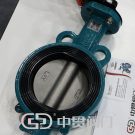Cast Iron Butterfly Valve
Cast iron butterfly valves play a crucial role in water distribution systems due to their durability and efficiency. They control water flow in treatment plants, municipal supply systems, and irrigation. Their robust construction withstands high pressures and temperatures, ensuring long-term reliability. With minimal maintenance, these valves offer cost-effective solutions for water distribution. Their versatility in handling different flow rates and pressures makes them essential in ensuring efficient water distribution.
Functions and Uses
- Flow Regulation: By rotating the disk, the butterfly valve can precisely control the flow rate of the fluid through the pipe. The valve can be adjusted to any position between fully open and fully closed, allowing for variable flow control.
- Shutoff: When the disk is turned to a position perpendicular to the flow, it provides a tight seal to stop the flow entirely. This makes butterfly valves useful as shutoff valves.
- Versatility: Butterfly valves can be used in a wide range of applications, including water supply, wastewater treatment, chemical processing, and HVAC systems. Their compact design and quick operation make them suitable for both on-off and throttling service.
Disadvantages
- Weight: Cast iron is heavier than some alternative materials, which might be a consideration in applications where weight is a critical factor.
- Brittleness: Cast iron can be more brittle than materials like ductile iron or stainless steel, making it less suitable for applications with high mechanical stress or impact.
In summary, a cast iron butterfly valve is a robust, versatile, and cost-effective solution for controlling fluid flow in a wide range of industrial applications. Its simple design and efficient operation make it a popular choice for many systems.
Types of Cast Iron Butterfly Valves
Cast iron butterfly valves are a common type of valve used in various industries for regulating flow. They are known for their simple design, durability, and cost-effectiveness. Here are the main types of cast iron butterfly valves, categorized based on their design and function:
1. Wafer Butterfly Valve
- Description: Designed to fit between two flanges in a piping system, the wafer butterfly valve does not have end connections. It is held in place by bolts passing through the flanges and valve body.
- Features: Lightweight, cost-effective, easy to install and maintain.
2. Lug Butterfly Valve
- Description: This type has threaded inserts (lugs) outside the valve body. It is designed to be installed between two flanges using bolts that pass through the lugs and flange holes.
- Features: Allows one side of the piping system to be disconnected without affecting the other side, suitable for dead-end service.
3. Double Flanged Butterfly Valve
- Description: Has flanges on both ends of the valve body, making it easy to install and align in the pipeline.
- Features: Suitable for applications requiring high reliability and where the valve might need to be removed frequently.
4. Concentric Butterfly Valve
- Description: The most basic type, where the stem and disc are centered in the valve body, and the disc seals against a resilient liner.
- Features: Simple design, cost-effective, suitable for low-pressure applications.
5. Double Eccentric (Double Offset) Butterfly Valve
- Description: The stem is offset from the centerline of the disc and the centerline of the bore, which reduces friction during operation.
- Features: Provides a tighter seal and longer lifespan, suitable for higher pressure applications compared to concentric valves.
6. Resilient Seated Butterfly Valve
- Description: Features a rubber or elastomer seat that the disc presses against to create a seal.
- Features: Provides a tight seal with low torque operation, suitable for low to medium pressure and temperature applications.
7. Manual Butterfly Valve
- Description: Operated by a hand lever or gear mechanism.
- Features: Simple operation, suitable for applications where automation is not required.
8. Automated Butterfly Valve
-
- Description: Equipped with an actuator (electric, pneumatic, or hydraulic) for automatic control.
- Features: Enables remote operation and integration with automated systems.
Conclusion
These types can be further customized with different materials for the disc, seat, and stem to suit specific application requirements, such as chemical compatibility, temperature, and pressure conditions.





